Liftvans and items going into liftvans for our move.
In 2022, we purchased an apartment in Italy after years of renting and that became the forcing function for moving our household goods in storage in the USA to Italy.
Here are the questions covered in this post:
Q1. What were the details of our move?
Q2. Why did we our separate artwork from household goods?
Q3. Any thoughts on packing?
Q4. Any risks on doing your own packing?
Q5. What did we do ahead of time (of the move)?
Q6. Any tips on finding a mover?
Q7. What happened in our case?
Q8. Any specific tips on moving to Italy?
Q9. How do you find the right balance of DIY and turnkey?
Q10. How did we get to this point?
Q1. What were the details of our move?
Q2. Why did we our separate artwork from household goods?
Q3. Any thoughts on packing?
Q4. Any risks on doing your own packing?
Q5. What did we do ahead of time (of the move)?
Q6. Any tips on finding a mover?
Q7. What happened in our case?
Q8. Any specific tips on moving to Italy?
Q9. How do you find the right balance of DIY and turnkey?
Q10. How did we get to this point?
What were the details of our move?
- We are do-it-yourself (DIY) types, so keep that in mind when reading this.
- We had all our household items in the USA, in a storage unit of 20’ x 13’. The items were wrapped and protected for storage, but nothing more.
- We had one month to organize, repack, sell stuff, and get ready for the pickup for shipping from the USA to Italy.
- We rented a temporary unit (10’ x 7’) for one month, down the hall from our original unit and we used it to have some space to maneuver. Our 20 x 13 unit was packed floor to ceiling with no wiggle room, so we moved things into the temporary unit to create space in the original unit. It turned out to be a smart move.
- At the end of one month, we gave up our original unit and the temporary unit. Out of storage for good!
- The two shipping companies we used (one for artwork and one for household goods) came directly to our storage unit to pick up our items for shipping.
- One shipper came and filled two liftvans with our household items.
- A liftvan is a plywood crate used in shipping.
- In our case, each liftvan was 200 cubic feet approx. 87” high x 87”x long x 48” wide.
- The shipper rewrapped our items in heavy craft paper and some padding. The shipper spent most time arranging the items in the liftvan so they were “tightly” packed. (See photo in this post.)
- The total weight of the two liftvans filled turned out to be about 3,000 lbs.
- Another shipper came for our artwork.
- That ended up – protected for shipping - being 2 crates: 96” x 33” x 51” (93.5 cubic feet) and 46” x 29” x 51” (39.4 cubic feet). (See photo in this post.)
- Total was 132.9 cubic feet, but remember, this is wrapped and padded to protect artwork.
- Wrapped for shipping, both crates were 795 lbs.
- When the shipper came to pick up our items, they were “lightly” wrapped just for storage. The shipper wrapped and consolidated our art at their facility. This is what we paid them to do.
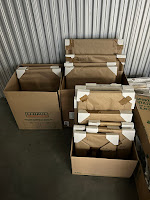
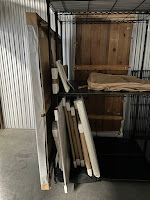

Organizing artwork before pickup by the shipper - left and center. Right: how the artwork arrived in Italy, crated.
Why did we separate our artwork from household goods?
- We weren’t confident that our artwork would be treated carefully with general household packing.
- Some of the shippers we talked to suggested it was better to ship (valuable) artwork by air.
- Shipping by air exposes your artwork to less temperature and jostling. At least that’s the idea.
- So, we chose a mover just for the artwork that shipped by air.
- It costs more to ship by air. For us, shipping everything (artwork and household goods) by air was way too costly.
Any thoughts on packing?
- The thoughts here are aimed at folks doing most of it themselves.
- Start early. Don’t wait until your stuff is to be picked up.
- Be organized. Keep like stuff together. For example, we had groups of boxes/bins we could easily say here are all the “books/document”, “kitchen stuff”, “artwork”, and “decorative stuff”.
- Use consistent sized containers if possible. Invest in boxes or plastic bins that are easy to stack and carry by one person.
- Label, label, label. Get yourself lots of blue tape and sharpies. Label and then relabel stuff as you shuffle items around. Nothing is more frustrating than having to guess what’s inside a box/bin that’s sealed.
- Packing blankets are expensive but useful. We had dozens of heavy blue packing blankets that we used originally to move into the storage unit, then used to protect items in the storage unit, and then finally used for wrapping of some household items as they went into liftvans. We also had a ton of bath and kitchen towels that we used to protect small items in bins and boxes. We also used bubble wrap and paper.
- Be ruthless and clean out before the movers arrive. The less you must move, the easier and less expensive (generally) the move will be.
- While organizing or packing, don’t get hung up timewise on small things or uncertain items. If you don’t know what to do with something, put it aside, move on, and circle back to it. Don’t argue with your partner or family members over stuff. Acknowledge something may be valuable to them, leave it on the table for discussion, and move on. Usually, the issue will work itself out.
- The day before shippers arrive to pick your stuff up, have a game plan of what might have to stay behind and what might go. For example, we had two liftvans to fill. We had done our volume estimates and we had a pretty good idea of what would fit. However, we had a list of things that could stay if the liftvans were full and things that could go if there was extra space. We are talking about smaller items at that point.
- A standard liftvan is approximately 200 cubic feet (87” high x 87”x long x 48” wide) though liftvans can be made to fit any sized shipment.
Any risks on doing your own packing?
- From a mover’s perspective, packing yourself may not always be helpful or welcome. Ask each moving company this question and see what they say.
- Moving folks will generally have more experience on the conditions your stuff has to endure, so theoretically should be better at packing. However, keep in mind that a mover’s biggest interest is getting in and out quickly. Likely, your pickup is one of many that day for them. If they are taking your stuff back somewhere to pack it, you’ll never know how they packed it until you receive it. (If the movers spend doing stuff you could have done, it may result in additional costs especially if they didn't understand your situation. Some companies will charge by floors they have to climb and hours spent packing. Ask!)
- We were told by one mover that at sea you should expect that creates could see up to 45% deviation from level. Whether that was pitch or roll or both, we don’t know.
- Understand any implications about insurance regarding packing yourself versus a mover packing. Insurance and compensation for issues might only work if items are packed by movers.
- In our case, for household items, the shippers came, rewrapped our boxes/bins in multiple layers of kraft paper and padding, and then played Tetris fitting the stuff into the liftvans. We started wondering how well our pottery pieces would do in the bins we packed. Did we use enough padding ourselves inside the bins? What if the whole lift van fell, would we everything end up in pieces?
- Finally, there may be some subtly in how customs in the destination country are handled if your stuff is considered “shipper-packed” or “personally-packed”. If shipper-packed, it may have an easier time getting through customs. Again, ask your moving company.
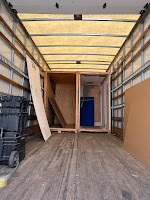

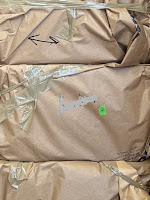
Photos of liftvans empty, being packed, and close-up of wrapped bins.
What did we do ahead of time (of the move)?
- Ahead of time should be thought of as months.
- We created inventories of items to be shipped, as detailed as we could.
- Values and sizes and volumes where possible.
- If you use lots of the same type of boxes or bins, getting an estimate of volume is easier.
- For example, we had all our kitchen stuff packed in bins and boxes and could easily estimate the volume.
- For valuable artwork, we had a spreadsheet of names, dimensions, and value. We had receipts and information about where items were bought and what we paid. Always keep this documentation with you, not with the artwork!
- What does valuable mean? As a rule of thumb, the monetary value of your total artwork should be at least greater than the shipping cost. Sentimental value is another calculation! The monetary value of our artwork compared to the shipping cost was like 5:1, so we felt like it was a good deal.
- Strange as it might seem, think about leaving some bigger pieces of artwork with friends, on a sort of permanent loan. We did this and found it to be a refreshing feeling.
- We shared many of our spreadsheets with shippers we contacted and worked with. It made their jobs easier when providing estimates.
- We talked a lot ahead of time about the size of household items we were shipping and tried to reduce bigger items from the list.
- Do a mental exercise with your partner or family and decide what items are important and which are not. Decide what you could live without in the new location. These decisions ahead of time will save you heartache later. Especially in the heat of packing, it’s easy to fight about what is or isn’t important. Those decisions should be made ahead of time.
- Items that were not being shipped were sold, went on consignment, or given away. There are tons of charities to take your stuff, however, don’t wait to the last minute. You often need weeks and maybe months of effort to find homes for some items.
Any tips on finding a mover?
- We started like everyone does, searching the web. And we started early.
- Reviews were all over the map. We saw wonderful stories and horror stories. It’s hard to read between the lines of these reviews or to even know what is real or not.
- We also had a few recommendations from friends and family who had recently moved. (One of these recommendations we ended up using for shipping our artwork.)
- Once we got a few names we thought were good leads, we started calling.
- We talked to several movers and got bids. At this phase, we started building out a list of questions and concerns for our situation. We think of this as our discovery phase. We learned something new from every engagement. One mover will mention something another didn’t. We spent many hours calling and building up our knowledge.
- At this point, we had some smooth talkers (hello Florida moving company!) trying to get us to sign right away and put all the money up front because our window of opportunity was closing. Don’t accept this pressure tactic if you don’t have to. We didn’t and are glad we didn’t because in our case the quote was high (as we would find out later).
- There wasn’t consistency how the move would work across the eight companies we engaged with.
- Some companies gave an estimate on scarce info like just the number of bedrooms while others needed on-site inspection or video call to “see” the stuff.
- Some of the movers quoted service end-to-end, freight-forwarding, and delivery to destination. Others asked us to coordinate at the receiving location (Italy for us).
- Most glossed over the part of how the process would work in Italy – which is famous for its bureaucracy – and that worried us.
- Accept that there will be uncertainty. Ask a lot of questions and expect you won’t always get clear answers or the same answers. Comparing movers is like comparing apples and oranges.
What happened in our case?
- We engaged with eight different moving companies across the country.
- IVL, Artex, Lile, Craters & Freighters, Bekins, an outfit out of Milan, a freight forwarding company, plus one other.
- After a few months we narrowed it down to two choices, one for household and one for artwork. Then out of the blue came a recommendation that we ended up going with for household. The lesson here is that planning is good but flexibility to change is also good. When we accepted the out-of-the-blue recommendation, we already knew what questions to ask and costs to compare with, so the discovery phase paid off.
- All told, we felt it was important to work with someone local to our origin. Someone who was geographically nearby or at least had an office or presence nearby. In our case, the packers (for both household and artwork) came to our storage unit, picked up stuff and brought it back to facility nearby for further repacking (as in the case of the artwork) or storage as in the liftvans for household items.
- The liftvans – again in our case – were packed on site, real time in front of our eyes and sealed shut.
- We know that our stuff went by truck to the port of New Jersey, then boarded a container ship. Our shipper sent us the name of the container ship so we could track it.
- For example, our ship is the OOCL Europe. The tracking is course but good enough to see where your stuff is. (You can pay to have more precise tracking but we didn't.) We know our stuff went from New Jersey - Norfolk Virginia - Miami - Algeciras - Livorno - Genova.
- We thought about putting a tracking device like an Apple AirTag into the liftvans to follow it ourselves, but we didn't. Is there such a thing as too much information?
Plastic bins before wrapped in kraft paper. A soft chair (with legs removed) and packing blanket. All items went into liftvans.
Any specific tips on moving to Italy?
- Our move was tied to circumstances of our residency and purchasing a home. Italy has a defined time period of 1 year after you declare residency in which you can ship your household items without paying duty. We didn’t even know such a deadline existed until we were well along the shipping process. At that point, we had exceeded a year, albeit in a rental. In the end, we were able to state that we had purchased an apartment within one year of shipping. That worked.
- Takeaway: Your destination country may have rules about how long after you’ve been in the country before you can ship your stuff without paying duties. What you don’t want to have happen is to have to pay an unexpected, large import tax on your household goods.
- Well, we thought we were out of the storage unit rental business and then wham! we were back in it in Italy. Our shipment of artwork (2 big crates) arrived just fine, and quickly. But there was a catch. One of the crates was too big for the lift on the usual DHL truck that makes the rounds in our new neighborhood. Only a larger truck with a stronger lift could handle the large crate, but that truck was too big to reach our house in the historic center. What to do? We scrambled and found a storage rental location where DHL could deliver the crates to. In the end, this turned out to be better because our new place wasn’t ready and storing the crates was a good idea.
- Takeaway: Think about the size of stuff to be delivered and how that will reach you, the famous last mile.
- In our case, we used storage for 2 months in Italy until our place was ready and we could move the art.
The storage unit. Left full at the start. Center getting ready for pickup. Right: Almost empty except for pallets.
How do you find the right balance of DIY and turnkey?
- It depends on the type of person you are and the money you have to do the move.
- If money isn’t a problem and your time is, then lean more toward a turnkey solution. That is, have a company do it all for you.
- If you need to be careful with costs - which we suspect is the case for most people - then you’ll probably be shopping around for good pricing, doing more of the packing yourself, and being organized before the shippers arrive.
- One of the shippers told us this story: They arrived at a customer’s house where nothing was packed. The shippers even had to pack silverware and dishes. Again, if this works for you, go for it, but you’ll pay for it. (You may find that you paid upfront one price but that didn't include all the unaccounted for time like illustrated in the story. This may result in additional charges that'll you'll have to pay before you can take possession of your items.)
- Our art and household stuff were already “downsized” and in a storage unit. Movers didn’t have to come into our house, pick up stuff, and wrap it. (You might pay more if movers come to your house.) This is all to say we were fairly organized about the move. We knew how many boxes of books we had, how many kitchen boxes, how many boxes of pottery and decorations, etc.
- We wanted to understand every detail and risk, and we tended toward companies that were able to articulate detail and risks to us. One of the shippers was turnkey and waived off all concerns we raised...just that we had to pay upfront and it turned out to be one of the higher priced solutions we found.
How did we get to this point?
Here are a couple of points along our journey from visiting Italy to living in Italy.
- Finding a Place to Stay in Florence - Back in 2007, we decided to take a 9 month leave of absence from our jobs and lives in the US, and go to Italy. We call this Sabbatical 1. We thought we would wander around Italy but in the end stayed the whole time in Florence.
- Path to Italian Dual Citizenship - One of the things that occurred to us on our first sabbatical was that we could - with our family history - apply for Italian citizenship and so started that process in 2010, while living back in the states. Sabbatical 1 seemed like a distant memory.
- Getting Our Italian Passports - Our Italian citizenship was approved and our passports came in 2011, while living in the states.
- For several years, we keep thinking about Sabbatical 1 and dreaming of Sabbatical 2.
- Bergamo to Canto Alto Hike - Let Sabbatical 2 begin and what way to begin than with a classic hike to a local peak.
- Sabbatical Lessons: Thoughts and Stories from our Italian Sabbaticals - In 2017, we reflect back on our two sabbaticals.
- Seven Days on the Sentiero delle Orobie – A Journey Through the Bergamo Alps - In 2018, we celebrate with another classic hike. The celebration: we decide to transition from sabbatical to just living. There isn't any particular dividing line for that decision and this hike is as good as any.
- 2022 and this post, we are shipping our stuff over. 15 years since the idea/leaving for Sabbatical 1.
Epilogue
Our artwork (by air) arrived about 2 months before our household items (by ship). Our artwork we stored temporarily in a Bergamo storage unit (Casaforte - nice folks) and then rented ourselves a van and brought it to the house. That was a tiring day.
The day the household items arrived, a 5 person crew showed up from Bliss Moving. Our items had already be taken from the liftvans (see above) and placed in a truck that showed up at our doorstep. Inside the truck there was an mini-freight / goods elevator (montacarichi or montacarico). At first the crew wasn't sure they were going to use it. Then, they saw that we were on the 4th floor (3rd floor in Italy) and they didn't feel like bringing up 80+ items (boxes, furniture, misc.).
So in tough conditions of rain and a sloping street, the crew erected a goods elevator. That's how all the goods arrived into the house. Our kitchen window to be precise. 3 guys in the street sent stuff up. 2 guys in our apartment unloaded. We furiously unwrapped so that we could have the crew dispose of the trash. (An important part of moving is getting rid of trash generated and any chance you can, get the movers to haul it away.)
We did not have to pay customs on any of our items (art or household). The moving side in Italy went well - no hitches other than one mentioned about art crates described above. We are still unpacking at this moment - but things seem all in good shape. Stay tuned.
Left: Tracking the container ship from the USA to Italy.
Center left: The movers arrive, the goods elevator on the ground, and a nun to bless it all.
Center right: The goods elevator extending to the 4th floor.
Center left: The movers arrive, the goods elevator on the ground, and a nun to bless it all.
Center right: The goods elevator extending to the 4th floor.
Right: A wad of wrapping paper goes down the elevator to be disposed of.






.JPG)

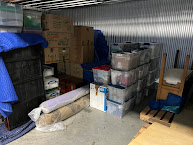





What mover did you end up using for household nj-it? Thanks!
ReplyDeleteWe used Craters and Freighters (Seattle) for artwork and Bekins NW for the rest.
ReplyDeleteGood luck with the move!
DeleteWow. What detail and organization. Very much appreciated. My concern is the handling, staging and delivery of our belongings into a) the historic center of our walled-city, b) up to the apartment and c) disposal of all of the crating, paper and general refuse of the move. You mentioned a storage fax in Italy for the artwork, storage units are not a widely accepted concept where we are moving - at east I've never seen one. Could/would the Italian movers provide such a service?
ReplyDeleteYou're welcome. So cool that you'll be in a walled-city! Okay, some attempts at answers:
Deletea) Like mentioned above, we had problems getting a large crate (of artwork) to our apartment due to the street size and availability of truck. This was a very large crate and may not be your case.
It's hard for us to give a definitive answer, because each mover/shipper will be different.
b) Moving stuff from the street to the apartment depends on your situation. Is there an elevator? Are the stairwells and doors okay to accommodate items? As mentioned above, in our case they hooked up a simple freight elevator and brought all the stuff in through open windows - see photo. Luckily, everything fit through the window.
Take some measurements of your new place to be sure. Ask ahead of time, if movers are okay to bring stuff up stairs or whatever your case may be.
We carried our artwork pieces up the stairs, one by one because we are just that way. (This happened weeks before the household stuff arrived.) We unpacked the artwork at the storage facility, loaded a small van, and brought the piece to our new house.
c) We asked the moving company to take the wrapping and crating away and they said yes. We were unwrapping as fast as we could. In one of the photos you can see a big ball of wrapping (mostly plastic, heavy paper, and cardboard) going down the freight elevator.
Even with that help, we were left with lots of towels (inside bins and boxes) and a lots of plastic bins. Go to you nearest charity (or centro di ascolto) and donate the stuff. That's what we did.
Other points:
Yes, storage facilities are not as common as the USA but are increasing in Italy. We were fortunate, in that there was one just a few miles from our house where we could storage our big artwork crates. The situation was that DHL said, hey we can't get these to your house. We had DHL deliver to the storage facility Casaforte. That was 2 months of storage - at a reasonable rate.
The Casforte arrangment was pretty formal/informal. Instead of renting a separate, super-secure space, we rented a space in a locked common area. (Since our art was in huge crates, we thought that was good enough.)
For your final destination, look around for self-storage. If you can't find any, start asking people for use of a possible garage or other safe space you can borrow or rent for short term. Obviously, if you can get everything directly from mover/shipper to final destination that's the best outcome.
If you can't find anything, the movers might hold on to your stuff, likely for a per day cost. You'll have to ask.
Hi. Our move is scheduled for June11, LAX to Lucca. We are going with Allied. Did you cover insurance in your post? I am having difficulty insuring everything for $1800, which is a lot to pay in the event of damage or loss.
ReplyDeleteHow exciting....Good luck! Found some ballpark numbers....
ReplyDeleteFor household shipment (went by sea) - insurance was provided through our moving company, in our case Bekins. The insurance carrier that Bekins used provided insurance based on weight ($/pound) and/or an itemized inventory. We went with weight-based AND itemization of just a few items with values over a threshold amount (like $2500).
- Our total weight was ~ 2900 lbs.
- Our total insured value was about 50k, based on pounds and itemized stuff.
- Our Insurance < $1000
Take this with just one data point in time and under conditions when we moved. Costs and other things may have changed since then.